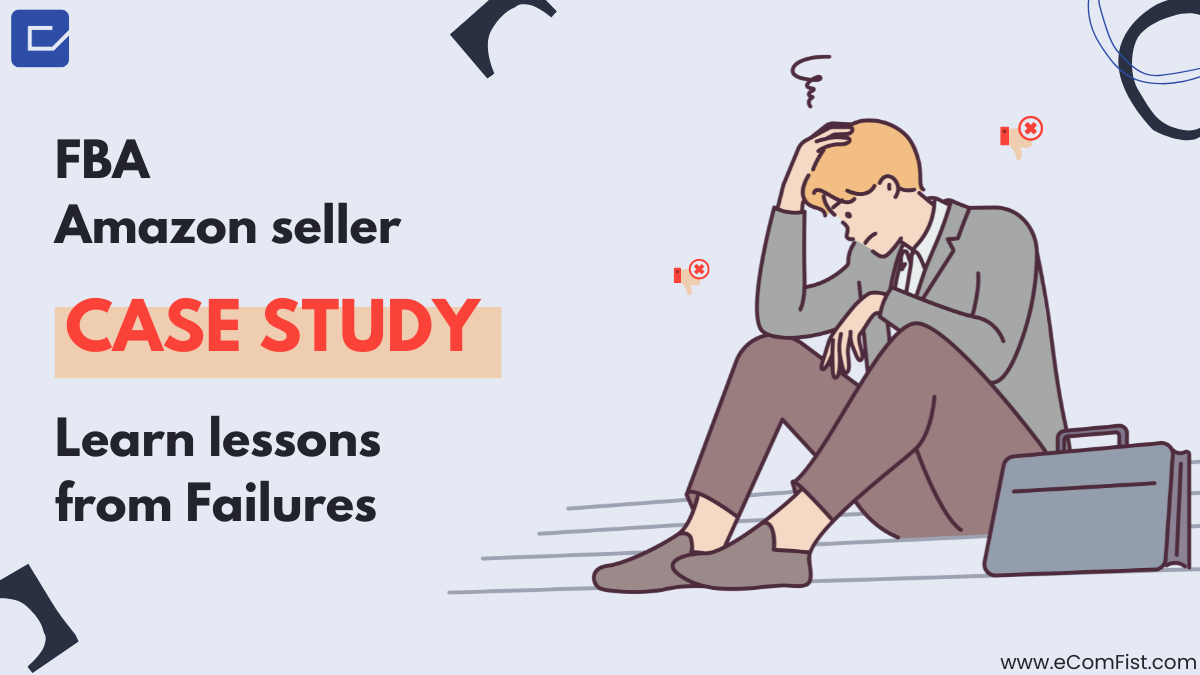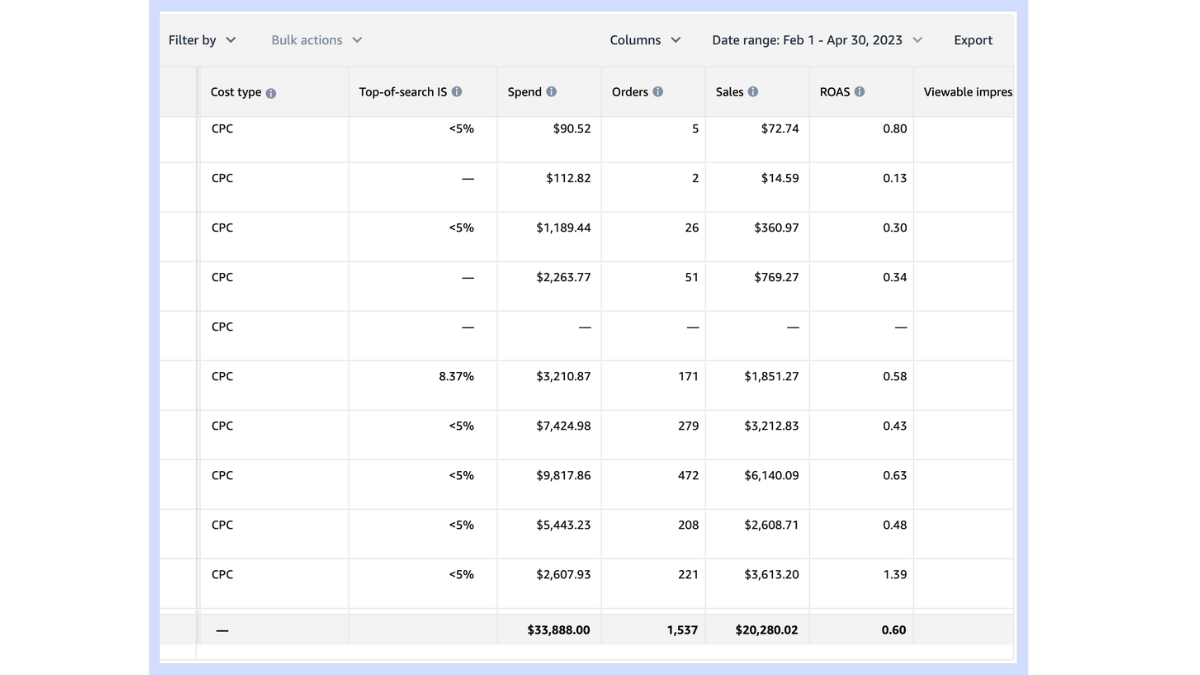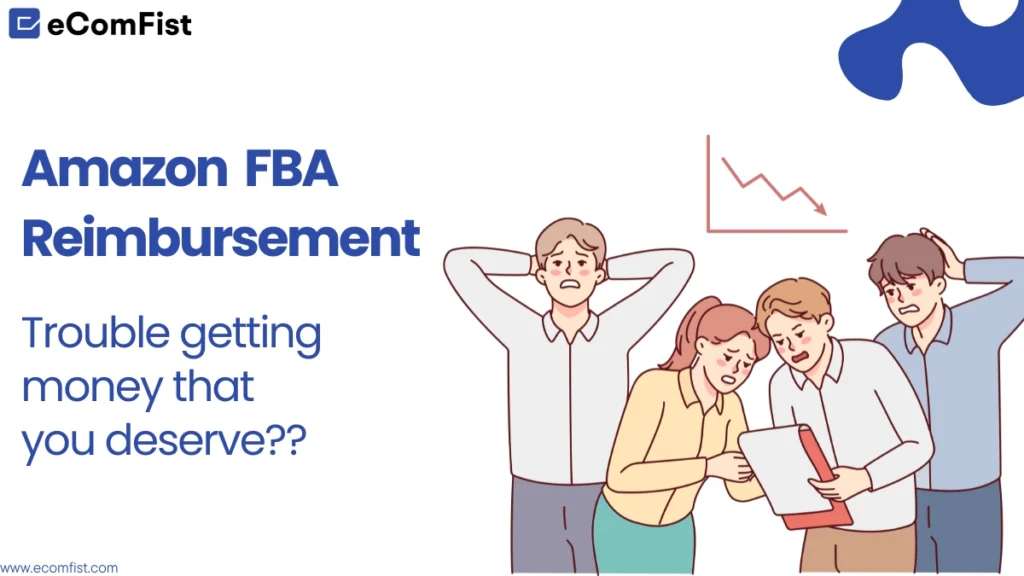The internet overflows with stories of Amazon sellers who have made it big in the Amazon FBA business, but it’s important to remember that it’s better to learn from the mistakes of others than from their successes. Seeing the mistakes of others can help us avoid making the same ones ourselves. It prevents us from placing an impractically high value on our false expertise. This Amazon FBA case study shows how ignoring market research, keyword research, and product selection without demand or differentiation from other Amazon sellers can lead to business failure in the long term.
I will also demonstrate the steps of failure using relevant statistics and data images, showing how making the wrong selection of products can lead to failure, even when investing heavily in Amazon PPC.
Let’s get started.
Background of FBA seller (John)
John contacted eComFist in hopes of boosting his brand’s revenue. All of his 17 goods were failing to meet his expectations, and he was becoming increasingly concerned. He launched 11 products at the end of 2022 and 6 products between January and March of 2023, spending tens of thousands of dollars, yet his entire business on Amazon has fallen apart without any sign of turning a profit.
Before he joined us, he had been investing heavily in PPC ads for three months in an effort to boost sales. However, ACOS was extremely high when compared to expenditures, at 167.10%. He initially came to eComFist in search of Amazon’s advertising service, but after we conducted an initial brand analysis, we began to suspect another issue and instead suggested him undergo an Amazon account audit.
Basic information
Niche: Clothing, shoes and Jewellery
Market: USA
Total investment: $100,000++
Total spend on PPC Ads: $53,000++
Total Revenue made: Very Poor
Profit margin: $0
ROI: below average
The following statistic will show you the poor health of John’s Amazon brand. Compare sales with prices.
Picture: Amazon FBA sellers’ stats showing the poor health of brands
In our account auditing process, we have found out the following reasons for poor sales and low revenue.
1-Poor market research and product selection
Market research provides insights that can help you make more informed decisions about your product launch. Without it, you may be launching a product that nobody wants or needs – Jeff Bezos
In our training for the new Amazon virtual assistant at eComFist, we encourage them to concentrate more on market research and competitive analysis of a product than other parts. There is a solid reason for doing this. I believe every product that performs poorly can be improved, except for the fact that no product or market research was conducted prior to launch. Here, the same problem occurs which is launching 17 products without doing market research.
How surprising!
Because of this, the inventory is stranded, and John is throwing money out the window by paying for storage while not actively selling it. As inventory never sells out, product costs are rising.

It’s not just that inventory is sitting around doing nothing; the sell-through rate is so low, it’s below 40% (which is below the average).

Adverse effects of product launch without market research
Following are the adverse effects that could happen because of neglecting market research.
- It’s possible that the market your product will enter is already flooded with products from larger brands. New sellers may have a hard time competing with established ones because larger brands typically have more capital to pour into marketing and advertising. Attracting customers and making sales will be difficult due to the high level of competition in the market.
- Without thoroughly researching the marketplace, you risk launching a product that is similar to those already on the market with great positive feedback. Your product’s sales and profitability could suffer if buyers have no reason to buy it over similar ones.
- Due to the high volume of competitors, selling products without conducting market research can potentially reduce profit margins. Due to economies of scale, larger brands might potentially sell their products at lower prices, making it challenging for new sellers to compete on pricing.
These are the main reasons for the poor performance of our client’s products. Since the entire market was so competitive and dominated by larger brands, none of the products were doing well.
2-Poor product manufacturing
A product’s quality is also crucial to its overall success. Customers won’t buy from you if the quality isn’t up to par due to the poor reviews given by previous buyers.
John’s products suffered the same fate. See below for reviews from customers who are complaining about the product’s quality and sizing problems. Typically, customers make purchasing decisions based on the feedback of existing customers. So, do you believe they will buy something from a product listing that only has 3.2 reviews?
Yes, I completely disagree with entering a market where well-known brands already dominate. However, if you do manage to get into such a market, you had better have a flawless product, or you may say your Amazon business plans goodbye.
4-Poorly optimized product listings
In order to provide customers with information about a product while maintaining keyword relevance, well-optimized listings are required. Here, our comprehensive research reveals that not a single one of these 17 products has a product listing rating higher than 6.8 on Amazon. Moreover, the product titles are not even optimized with the relevant keywords.
Not only that, but the vast majority of the reviews left on the various product pages complained that the products were not as described. This means that the details provided in the product listings do not accurately reflect the nature of the product being sold. Moreover, listings are not keyword-focused, which reduces visibility and conversion rates. It seems to be one of the reasons why products fail.
5-Failure of Amazon PPC
After the product’s first launch, John made a number of costly investments that were beyond the specified budget. For nearly six months, he ran a highly competitive Amazon sponsored product ad with increased bidding on keywords that weren’t even included in the product listings. Due to this high spending, the brand burned through $33,000 in just three months, generating only $20,000 in sales with 164.2% ACOS and seemingly making no profit.
You can even compare how much you spend on every keyword to the total number of orders, sales, and ROAS.
6-Negative customer reviews
It’s absurd to think that “Why are customers leaving negative reviews?” if the product launch’s foundational phases (market research, manufacture, testing, listing, and Amazon PPC advertising) were poor.
It’s not surprising that there is negative feedback about John’s products, but what is shocking is that two of his other products have neither reviews nor any sales. It exemplifies the catastrophic failure caused by insufficient market research, in which the absence of demand goes unnoticed.
7-Lack of Amazon storefront
Although all of the previous product launch steps—from product research to Amazon PPC marketing—appear to be unsuccessful, John’s 17 launched products suffer from the absence of an Amazon storefront.
Because branding is all about making sure that your brand name is the first thing that comes to clients’ minds whenever they think of making a purchase linked to your products, having a brand without an Amazon storefront is pointless. Moreover, with storefront, you can even take the benefits of sponsored brand ads and sponsored display ads. however, we don’t highlight this flaw in the products’ failure.
Reviving Failing Products: The Proven Strategies of eComFist
The above description was the whole analysis of John’s Amazon brand. And we adopted several strategies to revive the failing products.
- Conduct a thorough analysis of the market and competitors.
- Improve the quality of all product listings.
- Instead of throwing money at Amazon PPC, consider liquidating stock of certain unsold products while calculating all the pluses and minuses of liquidation.
- Strategize effective PPC campaigns for maximum results.
- Prepare plans for launching five more products after extensive study and testing (within the next 5 to 6 months)
- Develop an amazing Amazon storefront.
Efforts to recover investment
We cannot be held liable for John’s previous investment losses that occurred before he started using our service. However, we accept full responsibility for the investment loss that resulted from the stock liquidation of certain products. We have already given him a whole plan for the next year about our strategies and how we will recover.
We are hopeful about the next steps we are going to take for John’s progress.
Conclusion of the case study
There are so many lessons to learn, but these are just a few of the most important ones that could make or break your Amazon selling business.
- Launching a product successfully requires thorough research of the market, the product itself, and how it differs from competitors. Products won’t sell if their development is neglected.
- Always hire an Amazon full-service marketing agency that has proven competence in all of the above areas, from market research and listing optimization to PPC ad management and product launch. If you pay them a little more, you can prevent the loss of millions of dollars.
- It’s all about the customer. Even though it may sound silly, Amazon always puts the customer first. Your business needs to adopt the same philosophy in order to succeed.
Suggested Read: How and (why) to hire an Amazon marketing agency?
If you’re an Amazon seller concerned about potential losses, please contact us.














